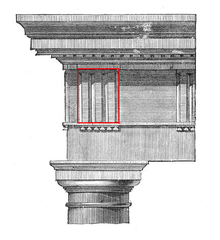Well, it's official I'm a three-time has been, that's right I was able to survive my third go-round as Worshipful Master. Please keep in mind that I say this with tongue firmly implanted in cheek.
It was indeed an honor to serve as Worshipful Master of Mt.Morris Lodge #535. This was my third time to serve in this capacity. My first term was at the ripe old age of 29 in Fellowship Lodge #490 back in 1990. After about a nine year hiatus I finally returned to lodge and went through the chairs, again, and served as Worshipful for Fellowship Lodge #490 in 2005.
Back to this year. The night I was installed my youngest son was supposed to present me with a gavel, but because of his then newly discovered illness he was unable to attend and I was not able to enjoy my installation to the fullest. It was a great installation, in my opinion and tempered the remainder of my term as Worshipful Master of Mt.Morris Lodge.
Our lodge had many successes to be proud of. We started the year off by having a few "poker-nights" which are fund raising events. What a great time at those events, great fellowship and camaraderie, and even some studying and quizzing of the ritual. There were some key players in these events with a host of casual helpers to make the whole thing a success.
We continued on with our monthly Country Breakfast fund raiser with a few charity breakfasts thrown in for good measure. Also, when the chips were down and many of the regular workers were absent because of Grand Lodge, one of the charities we help (through hosting a breakfast fund-raiser for them) came to our rescue and provided some workers to fill those vacancies. What a great display of good old-fashioned human kindness.
During the year we were able to raise 7 brothers to the sublime degree of a Master Mason. Along the way we took one candidate to Bay City for Joppa's Annual Fellowcraft Boat Degree, the boat was packed and it was hot! A great time was had by all.
We also did an unprecedented Master Mason degree on a Saturday following one of our Country Breakfasts. So, if the brothers wanted they could come and enjoy breakfast, a Master Mason degree and a fine tube-steak lunch afterwards.
Obviously we had a variety of degrees throughout the year. One of our last candidates of the year happened to be the son of WB Loren Bearup who took the east on all three degrees, which didn't hurt my feelings at all. What a tremendous thing to witness, a father bringing his son into the fraternity.
One of my favorite achievements this year was to rekindle an interest in Masonry for a brother who I was the top-line signer for some 25 years ago; while at a fish dinner in Grand Blanc I saw this brother and merely suggested that since I was in the east again, he should come out and have some laughs. Well, he did come out and since that time has done quite a bit of traveling and also took an office in his own lodge. Sometimes all it takes is for someone to say, hey why don't you come back to lodge....everyone would love to see you.
I wish it was always that easy. I've made many phone calls throughout the year and have encouraged, invited, and nearly begged brothers to come out, unfortunately without much success. We do have one brother who came back from a several year hiatus and is thoroughly enjoying his Masonic journey.....enjoying it so much that he resumed his place in line and was installed as Senior Warden. It's a great pleasure to have Billy T back in the swing of things with such enthusiasm.
Sometimes it's the small victories that mean the most. The ones which too often we take for granted. The small victories often pay really big dividends. We did have one major victory....a new metal roof. The JW remarked that at least fifty years from now the brothers of Mt.Morris lodge won't be cussing us out for taking the cheap way out on the roof. This project was a collective effort over a few years time and some great leadership from the Temple Board and it's leadership. Also, they installed storm windows over all of the windows of the lodge and had some old unruly shrubs removed and dirt hauled in to back fill and there are plans to landscape and beautify the front of the building.
It's been said too many times but communication can make or break the success of any lodge. We've learned first hand that when communications go wrong usually the activity or event goes wrong also. In reality it's amazing that the communication is as good as it is. With all the tools of modern technology it seems harder now to contact someone than ever before.
One evening our candidate was nearly late for his degree. When asked about it he said that he helps a friend who is partially disabled to clean an office building so she can earn extra money. He goes to do the heavy lifting for her which allows her to keep the job and the extra money she earns in the process. Little did we know that he was already practicing some of the tenets of our profession before taking his degrees.
Another event was an anniversary, past masters, awards night which
included families and honorary members and their families. This was a
great evening and a lot of good fellowship, something which I hope
continues in the future.
To sum things up, my son is in a much better condition than a year ago. Our lodge facilities are in a much better condition than they were a year ago. Our lodge membership is in better condition than it was a year ago. Our fellowship, commitment, and camaraderie is in better condition than a year ago. What a great year in Masonry at Mt.Morris Lodge #535.
Giving the dedicated Masons of Ancient District 20 a voice in addition to offering a vehicle to stimulate thought and discussion regarding the craft.
Thursday, December 20, 2012
Tuesday, December 11, 2012
'Tis the Season for Installations
It most certainly is the season for the Installation of Officers throughout our great state of Michigan.
Each time I attend an installation I am reminded of something from my DeMolay days. Long, long ago while in DeMolay one of our many duties was to pull chairs for the Masonic Installations. We are talking the winding down of the glory years in Masonry.
I joined DeMolay in 1974 and remember vividly working the installations. My chapter was in the Flint Masonic Temple where there were 5 Masonic Lodges, 3 OES chapters, 2 Jobs Bethels, DeMolay, York Rite including Chapter, Council, and an enormous Commadery and many other affiliated bodies.
It was December of 1976 and WB Howard Durbin was being installed as Worshipful Master of Fellowship #490 for the upcoming year of 1977. We were at our post ready to pull chairs out of the Blue Room after each officer was installed.
My DeMolay brother Rickey Malone motioned for me to come over where he was. He told me to go into the Blue room before the installation started and to look at all the people. He said, " When you get in there pretend you are looking for someone, so you can check out all the people." So, obligingly I did exactly that and came back out after a minute or so.
I asked Rickey why he had me do that. He responded, " I wanted you to take a look at all the people in there, over 400 in fact. You will never see that many people at another Masonic Installation. I don't care how many you go to over the years, you will never see that again."
That scene plays out in my mind every year as we enter into the installation season. Rickey was right, I've never seen that again. In fact sometimes there is more like 40 not 400. Now I will be the first to admit that WB Howard Durbin was a legend in his own time when it came to Masonry. He also had tons of non masonic friends which may have contributed to the huge turn out at his installation.
It was not uncommon in those days to have 200 show up for an installation. The officers being installed were most generally being installed in that office for the first time and their families were there. The installing officers usually had their wife or companion with them. It was a rare thing to hear " I'm traveling alone this evening." Now it is rare to hear someone introduce a wife or family member or friend whatever the case may be.
How is it that we have arrived at where we are today. Many things have changed in the last 40 years or as my mom says a lot of water has went under the bridge. One thing which has changed is the attitude toward our installation. Years ago it was a celebration, something to look forward to and to share a slice of Masonry with our relatives and friends. Now it has become more of a necessary task which needs to be performed.
Another thing is the closed installation. This was very rarely heard of or used back in the day because chances were that the Worshipful Master was being installed for the first time. I joined Masonry in 1983 and served as steward for 2 years then on through the chairs not skipping positions. When I finally did make it to the East it was a big deal not only for me but for my family because they were aware that it took 6 years to get there.
I understand that in the age of the recycled Master that an open installation is not necessary but there may be other officers who are being installed for the first time, and we miss out on a chance to "shine" in a situation that the public at large can witness.
A contributing factor to the relatively small attendance at installations these days is that as the population of the county has decreased severely so has the population of our Masonic Lodges in the county decreased. The attendance numbers are spread out among some 16 lodges in the county. On the same thought those lodges were in existence years ago and they had some very large turn outs as far as attendance goes......but there is no denying the fact that Genesee County's population has shrank considerably.
Taking that into account, then perhaps the 16 some lodges still being open and functioning says something positive about the situation, that they are still able to assemble a corps of officers.
When it comes to the attendance at the installations I suppose one thing that can be surmised is that the installation of officers is not that important to the officers and their families. Things which are important seem to always have time made for them. It's funny how society in general has changed over the years. Other events such as funeral home visitations brings into question the dress of those visiting. My mom's friend passed away and the attire of her family was less than fitting for a funeral, in my mind it was very disrespectful to a wonderful woman. I think it is just a sign of how things have become less important to people over the years.
A brother who had been away from the craft for a number of years with a little encouragement has been attending some events lately. His comment was that he can't believe the dress of those attending lodge.
My response was that yes a lot of things had changed over the years and dress requirements was one of them.
Somehow we have to instill in our new members the importance of this Fraternity. That really is our job to sell them on the benefits to them socially and morally. In addition to that we have to have some activities beyond meetings and degree work. We need to be more socially active with each other. We learn in our lectures that man was created for the social and active life, the noblest part of the work of God.
Looking back on the glory days, the fraternity was a huge social outlet.....and it was important to the men who participated and by it being important to those men....their families recognized that it was important and supported them in their endeavors. We have to lead the way and encourage our new brothers to involve their family and friends in their Masonic journey......and along with that we need to get our families and friends more involved by demonstrating to them the importance of the Fraternity and ensuring that we solicit their support in our endeavors.
Brothers, I've rambled on for long enough.....but take notice at the next installation you attend.....you may be surprised at where we are and find it hard to believe we were ever where we were only 40 years ago.
Each time I attend an installation I am reminded of something from my DeMolay days. Long, long ago while in DeMolay one of our many duties was to pull chairs for the Masonic Installations. We are talking the winding down of the glory years in Masonry.
I joined DeMolay in 1974 and remember vividly working the installations. My chapter was in the Flint Masonic Temple where there were 5 Masonic Lodges, 3 OES chapters, 2 Jobs Bethels, DeMolay, York Rite including Chapter, Council, and an enormous Commadery and many other affiliated bodies.
It was December of 1976 and WB Howard Durbin was being installed as Worshipful Master of Fellowship #490 for the upcoming year of 1977. We were at our post ready to pull chairs out of the Blue Room after each officer was installed.
My DeMolay brother Rickey Malone motioned for me to come over where he was. He told me to go into the Blue room before the installation started and to look at all the people. He said, " When you get in there pretend you are looking for someone, so you can check out all the people." So, obligingly I did exactly that and came back out after a minute or so.
I asked Rickey why he had me do that. He responded, " I wanted you to take a look at all the people in there, over 400 in fact. You will never see that many people at another Masonic Installation. I don't care how many you go to over the years, you will never see that again."
That scene plays out in my mind every year as we enter into the installation season. Rickey was right, I've never seen that again. In fact sometimes there is more like 40 not 400. Now I will be the first to admit that WB Howard Durbin was a legend in his own time when it came to Masonry. He also had tons of non masonic friends which may have contributed to the huge turn out at his installation.
It was not uncommon in those days to have 200 show up for an installation. The officers being installed were most generally being installed in that office for the first time and their families were there. The installing officers usually had their wife or companion with them. It was a rare thing to hear " I'm traveling alone this evening." Now it is rare to hear someone introduce a wife or family member or friend whatever the case may be.
How is it that we have arrived at where we are today. Many things have changed in the last 40 years or as my mom says a lot of water has went under the bridge. One thing which has changed is the attitude toward our installation. Years ago it was a celebration, something to look forward to and to share a slice of Masonry with our relatives and friends. Now it has become more of a necessary task which needs to be performed.
Another thing is the closed installation. This was very rarely heard of or used back in the day because chances were that the Worshipful Master was being installed for the first time. I joined Masonry in 1983 and served as steward for 2 years then on through the chairs not skipping positions. When I finally did make it to the East it was a big deal not only for me but for my family because they were aware that it took 6 years to get there.
I understand that in the age of the recycled Master that an open installation is not necessary but there may be other officers who are being installed for the first time, and we miss out on a chance to "shine" in a situation that the public at large can witness.
A contributing factor to the relatively small attendance at installations these days is that as the population of the county has decreased severely so has the population of our Masonic Lodges in the county decreased. The attendance numbers are spread out among some 16 lodges in the county. On the same thought those lodges were in existence years ago and they had some very large turn outs as far as attendance goes......but there is no denying the fact that Genesee County's population has shrank considerably.
Taking that into account, then perhaps the 16 some lodges still being open and functioning says something positive about the situation, that they are still able to assemble a corps of officers.
When it comes to the attendance at the installations I suppose one thing that can be surmised is that the installation of officers is not that important to the officers and their families. Things which are important seem to always have time made for them. It's funny how society in general has changed over the years. Other events such as funeral home visitations brings into question the dress of those visiting. My mom's friend passed away and the attire of her family was less than fitting for a funeral, in my mind it was very disrespectful to a wonderful woman. I think it is just a sign of how things have become less important to people over the years.
A brother who had been away from the craft for a number of years with a little encouragement has been attending some events lately. His comment was that he can't believe the dress of those attending lodge.
My response was that yes a lot of things had changed over the years and dress requirements was one of them.
Somehow we have to instill in our new members the importance of this Fraternity. That really is our job to sell them on the benefits to them socially and morally. In addition to that we have to have some activities beyond meetings and degree work. We need to be more socially active with each other. We learn in our lectures that man was created for the social and active life, the noblest part of the work of God.
Looking back on the glory days, the fraternity was a huge social outlet.....and it was important to the men who participated and by it being important to those men....their families recognized that it was important and supported them in their endeavors. We have to lead the way and encourage our new brothers to involve their family and friends in their Masonic journey......and along with that we need to get our families and friends more involved by demonstrating to them the importance of the Fraternity and ensuring that we solicit their support in our endeavors.
Brothers, I've rambled on for long enough.....but take notice at the next installation you attend.....you may be surprised at where we are and find it hard to believe we were ever where we were only 40 years ago.
Wednesday, November 28, 2012
The Covering
In the Entered Apprentice degree we are taught that a Lodge has a covering...... the covering of a lodge is a clouded canopy or starry decked heaven.....okay.
Delving into some of the meanings of the above mentioned phrase we find some interesting definitions of those particular words.
A covering is defined as something laid over or surrounding a thing for protection. Clouded refers to covering or laying over something as with clouds. In searching further a canopy is defined as a roof-like covering, an ornamental awning over a person of importance in ceremonial occasions.
Starry refers to abounding with stars or brightly lit by the stars. Moving forward the innocent word decked, means something that is covered or put under one roof. Heaven has many definitions and many different uses, perhaps the most interesting and appropriate for our use......heaven was a term used in Elizabethan Theater in reference to a wooden roof or canopy over the outer stage of the theater.
Elizabethan Theater took place primarily in London from roughly from 1567-1642. Permanent theaters were built for the plays of Shakespeare and others. Pretty interesting stuff considering this predated our fraternity by by less than a 100 years....maybe?????
So the lodge is covered or protected by a clouded canopy or awning of clouds over our important ceremonial occasions....or..... a star lit roof or heaven, if you will.
My interpretation is that during the daylight hours the Lodge is covered by billowing puffy clouds protecting us from the outside world and at night a star lit roof or canopy. Remember clouds are only visible during the day and I remember as a kid that sometimes it felt like a dome over us......visions of a canopy of trees also comes to mind.......also at night when the stars are in full display it gives the feeling that a heavenly dome covers over the earth. Now days when one ventures out of the city into the country at night and away from the light pollution of the urban sprawl this effect seems almost surreal as we've grown accustomed to our city environments.
Another illustration I believe they were trying to make was that the lodge....really the fraternity was covered or protected by a symbolic dome created by the Grand Architect. If one looks outside regardless of the location, because of the curvature of the earth the sky has a dome-like appearance. As we look toward the horizon the dome appears to end.....but as we move toward the horizon it is never ending....thus wherever we are we are beneath the dome. Therefore wherever we are with the fraternity we are under that covering.
Little did I know that when I started my search of this small passage that I would learn of the Elizabethan Theater and some of it's history. Obviously this influenced the writers of our ritual in trying to describe the heavenly star lit dome. They referred back to what they knew and were able to describe it. The word heaven has a very apparent dual meaning here.
Each time I engage in these brief studies I am simply astounded at what unfolds from so few words. It is quite apparent that the writers of our ritual had a very intricate understanding of words and how to use them, and to preserve their thoughts and illustrations for many years to come.
Delving into some of the meanings of the above mentioned phrase we find some interesting definitions of those particular words.
A covering is defined as something laid over or surrounding a thing for protection. Clouded refers to covering or laying over something as with clouds. In searching further a canopy is defined as a roof-like covering, an ornamental awning over a person of importance in ceremonial occasions.
Starry refers to abounding with stars or brightly lit by the stars. Moving forward the innocent word decked, means something that is covered or put under one roof. Heaven has many definitions and many different uses, perhaps the most interesting and appropriate for our use......heaven was a term used in Elizabethan Theater in reference to a wooden roof or canopy over the outer stage of the theater.
Elizabethan Theater took place primarily in London from roughly from 1567-1642. Permanent theaters were built for the plays of Shakespeare and others. Pretty interesting stuff considering this predated our fraternity by by less than a 100 years....maybe?????
So the lodge is covered or protected by a clouded canopy or awning of clouds over our important ceremonial occasions....or..... a star lit roof or heaven, if you will.
My interpretation is that during the daylight hours the Lodge is covered by billowing puffy clouds protecting us from the outside world and at night a star lit roof or canopy. Remember clouds are only visible during the day and I remember as a kid that sometimes it felt like a dome over us......visions of a canopy of trees also comes to mind.......also at night when the stars are in full display it gives the feeling that a heavenly dome covers over the earth. Now days when one ventures out of the city into the country at night and away from the light pollution of the urban sprawl this effect seems almost surreal as we've grown accustomed to our city environments.
Another illustration I believe they were trying to make was that the lodge....really the fraternity was covered or protected by a symbolic dome created by the Grand Architect. If one looks outside regardless of the location, because of the curvature of the earth the sky has a dome-like appearance. As we look toward the horizon the dome appears to end.....but as we move toward the horizon it is never ending....thus wherever we are we are beneath the dome. Therefore wherever we are with the fraternity we are under that covering.
Little did I know that when I started my search of this small passage that I would learn of the Elizabethan Theater and some of it's history. Obviously this influenced the writers of our ritual in trying to describe the heavenly star lit dome. They referred back to what they knew and were able to describe it. The word heaven has a very apparent dual meaning here.
Each time I engage in these brief studies I am simply astounded at what unfolds from so few words. It is quite apparent that the writers of our ritual had a very intricate understanding of words and how to use them, and to preserve their thoughts and illustrations for many years to come.
Friday, November 16, 2012
Where is the Pride ?
Something that has been bothering me is the lack of seriousness and pride displayed in our degree work. When a man is joining our great fraternity, one of the things which draws him to us is our rich heritage. Too many times we lack in promoting our heritage, traditions, and rituals to the candidate.
In my opinion this can be attributed to sloppy work, that is ritual work and sloppy floor work. When opening and closing our lodges the officers are often referred to by the wrong name, i.e. Brother Senior err....Junior Deacon err...Warden. It reminds me of when my kids were young and I would have to go thru all their names to arrive at the correct one....and at times exclaim, "whatever your name is come here."
It is very easy to mistakenly address an officer...but if we study and actually practice or rehearse this can be corrected. The same thing applies for the modes of recognition (tokens) and the signs. Think about this....put yourself in the place of the candidate....here he is joining the world's oldest and largest fraternity and the officers imparting the "knowledge" of the signs, tokens, and words can't properly demonstrate them and their meaning. The candidate begins to wonder if these are so important why are the officers confused and not sure of themselves.
Compare the scenario above to your chosen work, whether currently active or retired....if someone new came on the job site and you had to train the new person would you have the confidence and ability to clearly demonstrate to them how to do the job. My thinking is that you could clearly communicate to them and teach that new person how to do the job. This would be easily done because of repetition, dedication, and pride in your work....a chance to "show-off" a bit.
Where has the repetition, dedication, and pride in our Masonic work gone? The old saying is "that you only have one chance to make a good first impression." Admittedly we are all going to make mistakes, get confused and or nervous. However, at this stage of the "Masonic Year" the officers in place should have a good feel for their office and be able to "show-off" a bit and really impress these candidates.
In my opinion this can be attributed to sloppy work, that is ritual work and sloppy floor work. When opening and closing our lodges the officers are often referred to by the wrong name, i.e. Brother Senior err....Junior Deacon err...Warden. It reminds me of when my kids were young and I would have to go thru all their names to arrive at the correct one....and at times exclaim, "whatever your name is come here."
It is very easy to mistakenly address an officer...but if we study and actually practice or rehearse this can be corrected. The same thing applies for the modes of recognition (tokens) and the signs. Think about this....put yourself in the place of the candidate....here he is joining the world's oldest and largest fraternity and the officers imparting the "knowledge" of the signs, tokens, and words can't properly demonstrate them and their meaning. The candidate begins to wonder if these are so important why are the officers confused and not sure of themselves.
Compare the scenario above to your chosen work, whether currently active or retired....if someone new came on the job site and you had to train the new person would you have the confidence and ability to clearly demonstrate to them how to do the job. My thinking is that you could clearly communicate to them and teach that new person how to do the job. This would be easily done because of repetition, dedication, and pride in your work....a chance to "show-off" a bit.
Where has the repetition, dedication, and pride in our Masonic work gone? The old saying is "that you only have one chance to make a good first impression." Admittedly we are all going to make mistakes, get confused and or nervous. However, at this stage of the "Masonic Year" the officers in place should have a good feel for their office and be able to "show-off" a bit and really impress these candidates.
Thursday, November 15, 2012
The Great Spirit
I had the pleasure, honor, and privilege of visiting Fenton Lodge #109 which is located in historic Holly, Michigan. The purpose of last evening's special communication of Fenton Lodge was to confer the Entered Apprentice Degree on a Native-American candidate.
After a tremendous meal we moved to the lodge room to witness the degree. There were at least 50 brothers in attendance from many different lodges and areas represented along with a Grand Lodge Officer and several Grand Lodge representatives, Past Masters, and brothers from throughout the area.
What made this a slightly different EA degree was that the candidate placed his trust in The Great Spirit, and took his obligation at the altar of Masonry with the Holy Bible open and also his Sacred Emblems displayed along with the square and compasses.
As we are taught in Masonry to become a Mason you must profess a belief in a Supreme Being. Masonry encompasses many religions that believe in a Supreme Being and eternal life. This applies to most major religions, i.e. Muslim, Jewish, Mormon, etc.
Diversity is something that makes Masonry unique. There are many types of diversity; age, socio-economic, race, religion, level of education and others. Often times we tend to overlook the diversity aspect of our fraternity. As we progress further into the 21st. century diversity becomes more and more of a real issue.
Remember our fraternity started with operative masons, but through their teachings and principals they began to open up to "accepted" masons. Another thing to remember is that after the "building boom" of the renaissance period the number of "operative" masons began to diminish and the ranks of the fraternity turned more towards the "accepted" masons.
The founding of our own country was a result of the colonists seeking religious freedoms and the ability to worship according to their chosen faith.
This was truly a fine night in Masonry and one which was a true pleasure to witness the accepting nature of this great fraternity.
After a tremendous meal we moved to the lodge room to witness the degree. There were at least 50 brothers in attendance from many different lodges and areas represented along with a Grand Lodge Officer and several Grand Lodge representatives, Past Masters, and brothers from throughout the area.
What made this a slightly different EA degree was that the candidate placed his trust in The Great Spirit, and took his obligation at the altar of Masonry with the Holy Bible open and also his Sacred Emblems displayed along with the square and compasses.
As we are taught in Masonry to become a Mason you must profess a belief in a Supreme Being. Masonry encompasses many religions that believe in a Supreme Being and eternal life. This applies to most major religions, i.e. Muslim, Jewish, Mormon, etc.
Diversity is something that makes Masonry unique. There are many types of diversity; age, socio-economic, race, religion, level of education and others. Often times we tend to overlook the diversity aspect of our fraternity. As we progress further into the 21st. century diversity becomes more and more of a real issue.
Remember our fraternity started with operative masons, but through their teachings and principals they began to open up to "accepted" masons. Another thing to remember is that after the "building boom" of the renaissance period the number of "operative" masons began to diminish and the ranks of the fraternity turned more towards the "accepted" masons.
The founding of our own country was a result of the colonists seeking religious freedoms and the ability to worship according to their chosen faith.
This was truly a fine night in Masonry and one which was a true pleasure to witness the accepting nature of this great fraternity.
Wednesday, November 7, 2012
Secret Society Meets in Back-room of Polling Station
Can you imagine that headline in the newspaper. It could be used in today's paper and it would be somewhat true. We aren't a secret society as we all know but it makes for an interesting headline.
Our lodge is a polling station and wouldn't you know it was also our regular stated meeting. So, as the voting took place in our dining hall, we met and had our regular stated meeting and election of officers in the lodge room.
It was really neat that while we were meeting, voting was taking place. A perfect example of two of the many great freedoms we enjoy here in the United States of America. The ability and right to exercise our vote, and the ability and right to assemble. They both took place in the same building and at the same time!
Our lodge is a polling station and wouldn't you know it was also our regular stated meeting. So, as the voting took place in our dining hall, we met and had our regular stated meeting and election of officers in the lodge room.
It was really neat that while we were meeting, voting was taking place. A perfect example of two of the many great freedoms we enjoy here in the United States of America. The ability and right to exercise our vote, and the ability and right to assemble. They both took place in the same building and at the same time!
Tuesday, November 6, 2012
Forefathers....are we worthy?
There is something that has been on my mind for quite a long time, in fact I may have written about it before. If that is the case it bears repeating.
I had the pleasure of joining Freemasonry back in 1983, which afforded me the opportunity to meet many Masons who were legends in their own time and are still legends in local Masonic circles. Those men were true Masons and could always be counted on to assist in degree work, help a new brother with his lessons, encourage others to travel with them, and to be mentors to we younger brothers in the craft.
When I was around these brothers I took them for granted unfortunately. I suppose that I thought they would eventually be replaced by others coming up through the ranks. Knowing these men the way I did, I'm sure that they did not view themselves as legends in their own time and after.
There was something very special about those men who I met in my early days in the craft. They personified what a Mason was. They would whisper good counsel in your ear after a meeting to help clarify a word or correct some floor-work, etc. Many of these men created special relationships with the new or young brothers by teaching them and coaching them through their lessons.
Names like Durbin, Lyons, Malone, Hicks, Fredricks, Bishop, Love and numerous others. These brothers have gone to the celestial lodge above...but their memory and legacy lives on.
Who will the younger and newer brothers of today look up to? Are there any among us who are as worthy as these brothers were to be called a Mason? Will any of our work inspire any brothers to remember us 30 years from now?
There are many fine Masons who are very active currently. The shoes left behind by our forefathers are some mighty big shoes to fill, it is my hope that there are those who are wothy enough to dip their toes into those shoes. This is an amazing fraternity with some very amazing men.....I pray that some will continue the legacy of greatness left by those who have gone before us.
I had the pleasure of joining Freemasonry back in 1983, which afforded me the opportunity to meet many Masons who were legends in their own time and are still legends in local Masonic circles. Those men were true Masons and could always be counted on to assist in degree work, help a new brother with his lessons, encourage others to travel with them, and to be mentors to we younger brothers in the craft.
When I was around these brothers I took them for granted unfortunately. I suppose that I thought they would eventually be replaced by others coming up through the ranks. Knowing these men the way I did, I'm sure that they did not view themselves as legends in their own time and after.
There was something very special about those men who I met in my early days in the craft. They personified what a Mason was. They would whisper good counsel in your ear after a meeting to help clarify a word or correct some floor-work, etc. Many of these men created special relationships with the new or young brothers by teaching them and coaching them through their lessons.
Names like Durbin, Lyons, Malone, Hicks, Fredricks, Bishop, Love and numerous others. These brothers have gone to the celestial lodge above...but their memory and legacy lives on.
Who will the younger and newer brothers of today look up to? Are there any among us who are as worthy as these brothers were to be called a Mason? Will any of our work inspire any brothers to remember us 30 years from now?
There are many fine Masons who are very active currently. The shoes left behind by our forefathers are some mighty big shoes to fill, it is my hope that there are those who are wothy enough to dip their toes into those shoes. This is an amazing fraternity with some very amazing men.....I pray that some will continue the legacy of greatness left by those who have gone before us.
Friday, November 2, 2012
Preview of Things to Come
The Masonic Brother in search of the "Lost Word"
should not be on a hunt for a mystic term to be used like a magic spell. That
for what he really searches is to discover the Divine Truth within himself.
"While traveling upon the level of time towards that undiscovered Country from
whose borne no traveler returns." No one could tell me where my Soul might be. I
search for God, but God eludes me. I sought my Brother, and found all three.
Wednesday, October 31, 2012
Age ??
We learn in the MM degree that we will not aid nor assist in the indoctrination of an old man it dotage, or a young man in non-age. The definitions are interesting, and again one word represents a distinct meaning.
dot·age
[doh-tij]
noun
1.
a decline of mental faculties, especially as associated with old age; senility.
2.
excessive fondness; foolish affection.
non·age
[non-ij, noh-nij]
noun
1.
the period of legal minority, or of an age below 21.
2.
any period of immaturity.
I've always recognized that dotage referred to an elderly man. What this points out is that an elderly man is capable and qualified to join if he is possession of his faculties. Also, in our case in Michigan, 19 is the minimum age to join. Keep in mind that a 40 year old could be too immature to join or a 40 year old could have a decline in his mental faculties.
Once again the authors of the ritual covered all of the bases with two simple words......amazing stuff.
Tuesday, October 30, 2012
Really ? You Don't Say ?
Tubal-cain
From Wikipedia, the free encyclopedia
Jump to: navigation, search
For other uses, see Tubalcain (disambiguation).
| Tubal-cain | |
|---|---|
 Tubal-cain in his forge. Tapestry in the Musée de Cluny |
|
| Born | Tubal-cain |
| Other names | Tubal-Cain, Tubalcain, Tubal (simplified name) |
| Occupation | smith |
| Known for | forefather of smiths |
| Title | "an instructor of every craftsman in bronze and iron" |
| Parents | Lamech and Zillah |
| Relatives | Jabal (half-brother) Jubal (half-brother) Naamah (sister) |
Name
In Hebrew his name is תובל קין. In the King James Version this is rendered as Tubalcain, in the New International Version it is Tubal-Cain, while in the English Standard Version it is Tubal-cain. Rashi interprets the name to mean "he who spices the craft of Cain."[1]It is not clear why he has a double-barrelled name. Gordon Wenham suggests that the name "Cain" means "smith" (which would anticipate the remarks about his metal-working skill), or that he is called "Tubal Cain" in order to distinguish him from the other Tubal, the son of Japheth.[2]
Henry Morris suggests that etymologically, his name is "the progenitor of the name of the Roman God Vulcan."[3]
Coggins suggests it "may be a variant of the same tradition which lists Tubal in the table of nations" at Gen 10 2, as a land well known for metalwork.[4]
Occupation
Genesis 4:22 says that Tubal-cain was the "forger of all instruments of bronze and iron" (ESV) or an "instructer of every artificer in brass and iron" (KJV). Although this may mean he was a metalsmith, a comparison with verses 20 and 21 suggests that he may have been the very first artificer in brass and iron. T. C. Mitchell suggests that he "discovered the possibilities of cold forging native copper and meteoric iron."[5] Tubal-cain has even been described as the first chemist.[6]Others connect Tubal-cain's work to making weapons of war. Rashi notes that he "spiced and refined the Cain's craft to make weapons for murderers."[1] In The Antiquities of the Jews, Flavius Josephus says that "Tubal exceeded all men in strength, and was very expert and famous in martial performances, ... and first of all invented the art of working brass." Walter Elwell suggests that his invention of superior weapons may have been the motivation for Lamech's interest in avenging blood.[7]
Alternatively, E. E. Kellett suggests that Tubal-cain may have been a miner.[8]
| Wikimedia Commons has media related to: Tubal-Cain |
References
- ^ a b Rashi, Bereishis, chapter 4.
- ^ Gordon Wenham, Genesis 1-15 (Word, 1987), 113.
- ^ Henry M. Morris, The Genesis Record (Baker, 1976), 146.
- ^ Richard Coggins (1981). Who's Who in the Bible. London: Batsford. p. 154. ISBN 0-7134-0144-3.
- ^ T. C. Mitchell, "Tubal-cain," in New Bible Dictionary (IVF, 1962), 1302.
- ^ "Tubal-Cain Acclaimed as Pioneer Chemist". The Science News-Letter (Society for Science & the Public): 142. August 30, 1941. JSTOR 3918014.
- ^ Elwell, Walter E. (1988). Baker Encyclopedia of the Bible. Grand Rapids, Michigan: Baker Book House. p. 2109. ISBN 0-810-3447-7.
- ^ E. E. Kellett (1922), "Some Old Testament Notes and Queries", Expository Times 33: 426
Thursday, October 25, 2012
Inundations and Conflagrations ??
In the Fellowcraft degree we learn about the two brazen pillars which were cast hollow, the better to serve as a safe repository against all inundations and conflagrations....huh ??
As it turns out they served as a safe repository against flood and fire.....that's right flood and fire.
Inundation---to flood, cover or overspread with water
Conflagration---a destructive fire, usually an extensive one
I've heard these words for many years and just never sought out their definition. In fact I've given that part of the lecture many times and was not sure of the meaning of what I was saying.....now I do.....so the next time I will have a better understanding of that part of the lecture.
We always hear after a degree while remarks are being made that there is much to learn about this craft...truer words can never be spoken. If we delve into the ritual and pick it apart and explore these terms it opens a whole new avenue to this great fraternity we call Masonry.
As it turns out they served as a safe repository against flood and fire.....that's right flood and fire.
Inundation---to flood, cover or overspread with water
Conflagration---a destructive fire, usually an extensive one
I've heard these words for many years and just never sought out their definition. In fact I've given that part of the lecture many times and was not sure of the meaning of what I was saying.....now I do.....so the next time I will have a better understanding of that part of the lecture.
We always hear after a degree while remarks are being made that there is much to learn about this craft...truer words can never be spoken. If we delve into the ritual and pick it apart and explore these terms it opens a whole new avenue to this great fraternity we call Masonry.
Wednesday, October 24, 2012
What is a Lodge ?
It may take a while to get around to answering what is a lodge, but hopefully we can explore what a lodge means to all of us.
How many times have you said, "I'm going to lodge" or "See you at Lodge" or "When was the last time you were at Lodge?" or "Honey, we are having a dinner at Lodge and you're invited"
Sometimes we use the word Lodge to mean many different things.
What is a lodge? Is it the building where the lodge meets? Does Mt.Morris Lodge meet at the Mt.Morris lodge? .......or is Mt.Morris Lodge the members and officers of Mt.Morris Lodge which happens to meet at the Mt.Morris Masonic Temple ? by the way in my opinion....I've never bought into the Masonic Center name...again that is my opinion and not that of the Grand Lodge of Michigan.
If you look up the word lodge, it is a crudely built, temporary shelter. A more modern version is a hunting lodge but still a temporary or seasonal shelter not intended for long term use.
In Masonic jargon we use lodge to mean "the lodge" or for example, "I'm going to Swartz Creek Lodge" yes it means the location of where Swartz Creek meets but more importantly it means the brothers and officers of Swartz Creek lodge.
If something were to happen to the "building" at Mt.Morris or Swartz Creek or anywhere.....the lodge would continue on and just hold their meetings in a different "building" at a different location. Remember in the infancy of the craft in this newly formed United States, lodges usually met in an upstairs room of a tavern, and after the meeting they could get a pint, after all the water in those days would kill you, but that's another story.
I thought of all this last night during our Past Masters & Life Members banquet. I happened to step outside for a few moments and it was dark, cold, and rainy; when I went back into the "lodge" it was well lit, warm, and dry.....it suddenly dawned on me that the "lodge" is all the members, officers, honorary members, and their families......I had come in from the outside which was not pleasant at the time into the building which provided shelter from the inclemency of the current weather conditions.....and from a place of darkness and loneliness back into the warmth, light, and brotherhood of the "lodge"
I am sure that we have all heard a sermon or two at church discussing that "the church" is not the building but the congregation.....the same holds true for our lodges. Too often as of late we have lodges who have become slaves to their buildings and pour every ounce of energy into maintaining and paying the bills to keep the building or as we would term it the lodge......but the "lodge" is much more than a building, it's a living breathing brotherhood or fraternity that is ever growing and evolving.....as we learn in the Fellowcraft degree many majestic buildings have fallen or been destroyed but Freemasonry has survived through the ages.
We need to focus on the "lodge".....the true lodge---the brothers, officers, honorary members, and all of their families.....as our Deputy Grand Master Ray Lemons has said .....let's get back to Masonry....if we do Masonry correctly......the building will be taken care of.......let's focus on what is important and that is meeting the needs of all the members of the lodge.....they joined for a reason, lets give them a reason to be active and really enjoy the true meaning of going to .........lodge.
How many times have you said, "I'm going to lodge" or "See you at Lodge" or "When was the last time you were at Lodge?" or "Honey, we are having a dinner at Lodge and you're invited"
Sometimes we use the word Lodge to mean many different things.
What is a lodge? Is it the building where the lodge meets? Does Mt.Morris Lodge meet at the Mt.Morris lodge? .......or is Mt.Morris Lodge the members and officers of Mt.Morris Lodge which happens to meet at the Mt.Morris Masonic Temple ? by the way in my opinion....I've never bought into the Masonic Center name...again that is my opinion and not that of the Grand Lodge of Michigan.
If you look up the word lodge, it is a crudely built, temporary shelter. A more modern version is a hunting lodge but still a temporary or seasonal shelter not intended for long term use.
In Masonic jargon we use lodge to mean "the lodge" or for example, "I'm going to Swartz Creek Lodge" yes it means the location of where Swartz Creek meets but more importantly it means the brothers and officers of Swartz Creek lodge.
If something were to happen to the "building" at Mt.Morris or Swartz Creek or anywhere.....the lodge would continue on and just hold their meetings in a different "building" at a different location. Remember in the infancy of the craft in this newly formed United States, lodges usually met in an upstairs room of a tavern, and after the meeting they could get a pint, after all the water in those days would kill you, but that's another story.
I thought of all this last night during our Past Masters & Life Members banquet. I happened to step outside for a few moments and it was dark, cold, and rainy; when I went back into the "lodge" it was well lit, warm, and dry.....it suddenly dawned on me that the "lodge" is all the members, officers, honorary members, and their families......I had come in from the outside which was not pleasant at the time into the building which provided shelter from the inclemency of the current weather conditions.....and from a place of darkness and loneliness back into the warmth, light, and brotherhood of the "lodge"
I am sure that we have all heard a sermon or two at church discussing that "the church" is not the building but the congregation.....the same holds true for our lodges. Too often as of late we have lodges who have become slaves to their buildings and pour every ounce of energy into maintaining and paying the bills to keep the building or as we would term it the lodge......but the "lodge" is much more than a building, it's a living breathing brotherhood or fraternity that is ever growing and evolving.....as we learn in the Fellowcraft degree many majestic buildings have fallen or been destroyed but Freemasonry has survived through the ages.
We need to focus on the "lodge".....the true lodge---the brothers, officers, honorary members, and all of their families.....as our Deputy Grand Master Ray Lemons has said .....let's get back to Masonry....if we do Masonry correctly......the building will be taken care of.......let's focus on what is important and that is meeting the needs of all the members of the lodge.....they joined for a reason, lets give them a reason to be active and really enjoy the true meaning of going to .........lodge.
Friday, October 19, 2012
To sum up the whole.......long read but good info
The Classical Order columns
When deciding columns, the first order should be the classical order.
The classical order is one of the ancient styles of building design that is recognizable by the type of column and capital.
Classical columns are seen everywhere, on porches, entryways, or holding up a balcony, you probably just didn’t know their history.
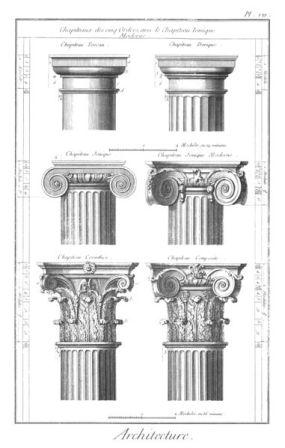
The classical order is one of the ancient styles of building design that is recognizable by the type of column and capital.
Classical columns are seen everywhere, on porches, entryways, or holding up a balcony, you probably just didn’t know their history.

From the sixteenth century onwards, there have been five recognized orders.
 The Doric
The Doric
 the Ionic
the Ionic
 the Tuscan
the Tuscan
 the Corinthian
the Corinthian
 the Composite.
the Composite.
 The Doric
The Doric the Ionic
the Ionic the Tuscan
the Tuscan the Corinthian
the Corinthian the Composite.
the Composite.
All
of these originated among the Greek architects and were modified by
others, particularly the Romans who took column structures to a
beautiful art.
The structure of a column
A column is divided into three parts- the base, shaft, and capital. The easiest way to distinguish between the classical orders is the capital.
The horizontal structure that is supported on the columns like a beam is called an entablature. The entablature is commonly divided into the architrave, the frieze and the cornice and each style has its own individuality.
A column is divided into three parts- the base, shaft, and capital. The easiest way to distinguish between the classical orders is the capital.
The horizontal structure that is supported on the columns like a beam is called an entablature. The entablature is commonly divided into the architrave, the frieze and the cornice and each style has its own individuality.
The Base
The stylobate is the flat pavement on which the columns are placed. On the stylobate is a square or circular block called a plinth. Above the plinth there may be another with molding profiles. These profiles are commonly the convex torus and the concave scotia, separated by fillets or bands.
The stylobate is the flat pavement on which the columns are placed. On the stylobate is a square or circular block called a plinth. Above the plinth there may be another with molding profiles. These profiles are commonly the convex torus and the concave scotia, separated by fillets or bands.
The column
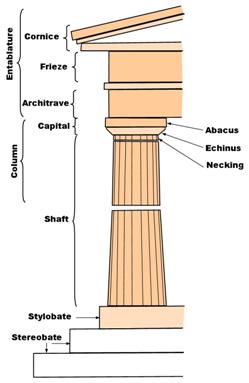

On top of the base is the column proper, or shaft.
Long and narrow, shaft heights are determined and measured as a ratio
between the diameter of the shaft at its base to its height. The shaft
is sometimes fluted or carved.
The capital
The capital sits at the top of the shaft. It is the capital that distinguishes the column orders from each other.
The capital is composed of three parts, the necking which sets on the shaft and has one or more grooves, the echinus which sets upon the necking and is a circular block, or large torus, and supports the abacus, which is a square or shaped block that in turn supports the entablature.
The capital
The capital sits at the top of the shaft. It is the capital that distinguishes the column orders from each other.
The capital is composed of three parts, the necking which sets on the shaft and has one or more grooves, the echinus which sets upon the necking and is a circular block, or large torus, and supports the abacus, which is a square or shaped block that in turn supports the entablature.
The entabulature
The entablature is the horizontal beam on top of the columns. It consists of three vertical layers which are separated from each other using moldings. The three layers have distinct names: the architrave is at the bottom, the frieze is in the middle and the molded cornice lies on the top. In some work the entablature may be an arch.
The entabulature is distinct to the column style.
The entablature is the horizontal beam on top of the columns. It consists of three vertical layers which are separated from each other using moldings. The three layers have distinct names: the architrave is at the bottom, the frieze is in the middle and the molded cornice lies on the top. In some work the entablature may be an arch.
The entabulature is distinct to the column style.
The 5 orders
Doric order
The Doric order is the oldest and is composed of a tapered shaft most often fluted. There is no base or capital in the Greek designs but the Romans used a base.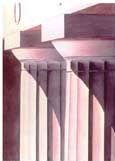
The top is often an inverted, shallow frustum or a carved torus. The height-to-thickness ratio is about 8:1.
Doric order
The Doric order is the oldest and is composed of a tapered shaft most often fluted. There is no base or capital in the Greek designs but the Romans used a base.

The top is often an inverted, shallow frustum or a carved torus. The height-to-thickness ratio is about 8:1.
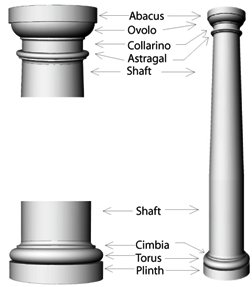
Tuscan order
Also a simple design, the Tuscan shaft is almost always smooth. The base and capital are cylindrical disks of alternating diameter. The height to thickness ratio is about 7:1. Because of the simple design of the style it was easily adopted by carpenters and became a distinguishing mark of the Georgian style.
Also a simple design, the Tuscan shaft is almost always smooth. The base and capital are cylindrical disks of alternating diameter. The height to thickness ratio is about 7:1. Because of the simple design of the style it was easily adopted by carpenters and became a distinguishing mark of the Georgian style.
Ionic order
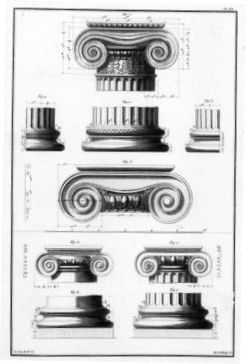

The Ionic
column is more complex and decorated. The base is a astragal and torus
and the shaft is often fluted. The capital has a volute at the four
corners. The height-to-thickness ratio is around 9:1. The Ionic column
is sometimes associated with academic buildings.
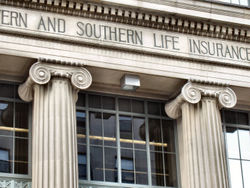

click to enlarge
 Corinthian order
Corinthian orderThe Corinthian capital uses no neck and instead has a ring-like astragal molding forming the base of the capital. There is an abacus on the capital which has concave sides that conform to the scrolling corners. There may also be a rosette at the center or each side.
The Corinthian order is named for the Greek city-state of Corinth. The story of the Corinthian capital is very interesting. The following is from the Wikipedia article on Callimachus, according to the Greek architectural historian Vitruvius....
A freeborn maiden of Corinth, just of marriageable age, was attacked by an illness and passed away. After her burial, her nurse, collecting a few little things which used to give the girl pleasure while she was alive, put them in a basket, carried it to the tomb, and laid it on top thereof, covering it with a roof-tile so that the things might last longer in the open air.
click to enlarge
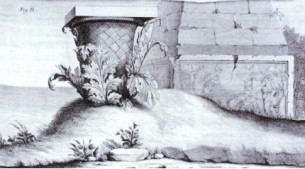 This basket happened to be placed just above the root of an acanthus.
The acanthus root, pressed down meanwhile though it was by the weight,
when springtime came round put forth leaves and stalks in the middle,
and the stalks, growing up along the sides of the basket, and pressed
out by the corners of the tile through the compulsion of its weight,
were forced to bend into volutes at the outer edges.
This basket happened to be placed just above the root of an acanthus.
The acanthus root, pressed down meanwhile though it was by the weight,
when springtime came round put forth leaves and stalks in the middle,
and the stalks, growing up along the sides of the basket, and pressed
out by the corners of the tile through the compulsion of its weight,
were forced to bend into volutes at the outer edges.Just then Callimachus, whom the Athenians called katatêxitechnos for the refinement and delicacy of his artistic work, passed by this tomb and observed the basket with the tender young leaves growing round it. Delighted with the novel style and form, he built some columns after that pattern for the Corinthians, determined their symmetrical proportions, and established from that time forth the rules to be followed in finished works of the Corinthian order.
click to enlarge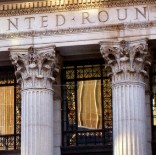
The oldest known Corinthian capital was dated at 427 BC. It is the slenderest column with a ratio 10:1. The base is similar to the Ionic base but the capital is the most decorative of the orders. Richly carved it projects a very expensive, elaborate air.
click to enlarge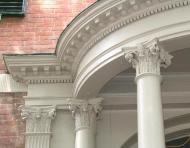

The oldest known Corinthian capital was dated at 427 BC. It is the slenderest column with a ratio 10:1. The base is similar to the Ionic base but the capital is the most decorative of the orders. Richly carved it projects a very expensive, elaborate air.
click to enlarge

Composite orderThe Composite order is a composite of the Ionic and Corinthian capitals. The acanthus of the Corinthian column already has a scroll-like element, so the distinction is sometimes subtle but the composite volutes are larger mand the echinus is decorated with egg-and-dart ornamentation between the volutes. The column of the composite order is ten - 12 diameters high.
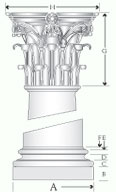
Solomonic
At least honorable mention must be given to the Solomonic column, which was the invention of Baroque architects in Europe.
click to enlarge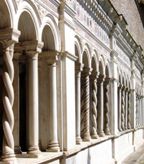 They were called “Solomonic” because they were based on a description
of columns in the great temple of King Solomon in the Old Testament.
They were called “Solomonic” because they were based on a description
of columns in the great temple of King Solomon in the Old Testament.
click to enlarge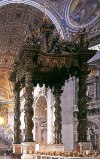 A Solomonic column has a base and ends in a capital like a classical
column, but the shaft twists around the shape of the column. The most
famous use of Solomonic columns is in the baldocchino designed by
Bernini for Saint Peter’s Basilica in the Vatican City.
A Solomonic column has a base and ends in a capital like a classical
column, but the shaft twists around the shape of the column. The most
famous use of Solomonic columns is in the baldocchino designed by
Bernini for Saint Peter’s Basilica in the Vatican City.
As mention previously the Solomonic column was revived as a feature of Baroque architecture. Used infrequently in Britain the columns became popular in Catholic Europe. The Solomonic column spread to Spain and from Spain to Spanish colonies in the Americas. After 1660, such spiraled columns became a familiar feature in the legs of French, Dutch and English furniture.
At least honorable mention must be given to the Solomonic column, which was the invention of Baroque architects in Europe.
click to enlarge
 They were called “Solomonic” because they were based on a description
of columns in the great temple of King Solomon in the Old Testament.
They were called “Solomonic” because they were based on a description
of columns in the great temple of King Solomon in the Old Testament.click to enlarge
 A Solomonic column has a base and ends in a capital like a classical
column, but the shaft twists around the shape of the column. The most
famous use of Solomonic columns is in the baldocchino designed by
Bernini for Saint Peter’s Basilica in the Vatican City.
A Solomonic column has a base and ends in a capital like a classical
column, but the shaft twists around the shape of the column. The most
famous use of Solomonic columns is in the baldocchino designed by
Bernini for Saint Peter’s Basilica in the Vatican City. As mention previously the Solomonic column was revived as a feature of Baroque architecture. Used infrequently in Britain the columns became popular in Catholic Europe. The Solomonic column spread to Spain and from Spain to Spanish colonies in the Americas. After 1660, such spiraled columns became a familiar feature in the legs of French, Dutch and English furniture.
(aka) Your everyday present mode columns.
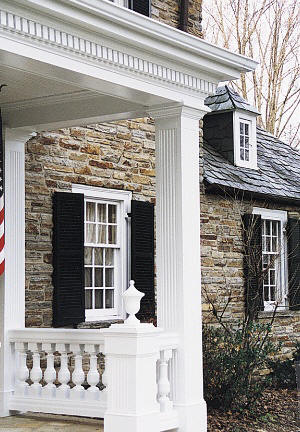 | A nice square,fluted Federalcolumn. |
click to enlarge 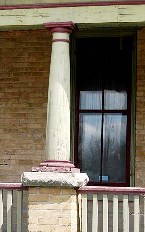 | 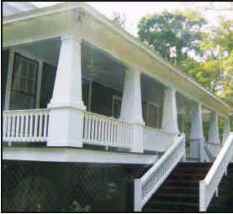 | 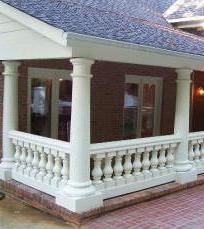 |
| Forshortened but relatively common.A Tuscan column. It has all the parts of classical order column and even sits on a stylobate. I belive this is what was called a Georgian column. | A nice set of tapered Arts & crafts columns on a Bungalow. | A different size Tuscan with heavy carved balusters. These are fiberglass. |
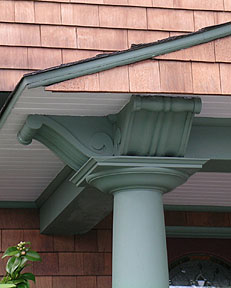 | 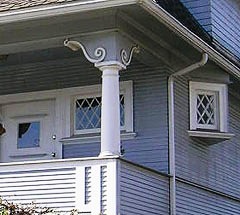 | 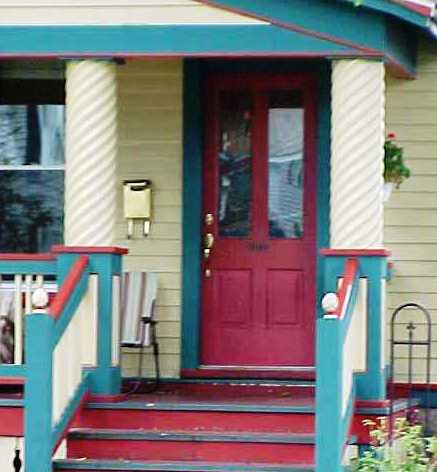 |
| A perfect example of an Arts & Crafts capital sitting on a Tuscan or a non-fluted Dorian column. The Echinus is common but I have not found any discription of its style. | Another Tuscan with a Arts & Crafts house. Notice the diamond mullion glass in the windows and the canted side stairway window. The trim below the porch edge is interesting. And the carved capital, the white curly-que design is called a 'Swans neck'. | I don't think you can call this a Solomonic column. It's either a culvert pipe painted or a concrete caste piece. I think a heavier abacus and stylobate and a thinner diameter would be very attractive. |
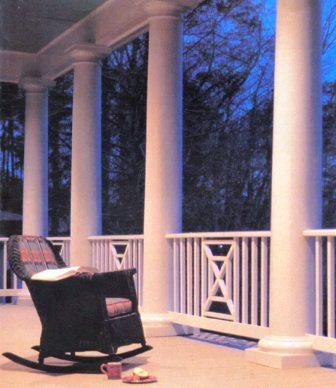 | 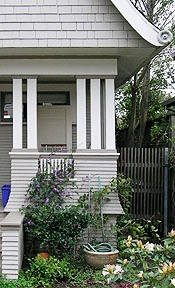 | 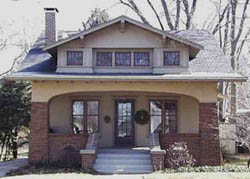 |
| Tall Tuscan columns. This shows what a difference a tall column makes to a space. | A very nice bungalow with multiple square columns. The curved skirt is called a 'Belcast'. The Bargeboard with the Torus Plate on the end is unique. | A Craftsman porch with a long arched entablature sprung in tapered brick columns. Whats different about this design is the columns start at grade and not at the porch level. |
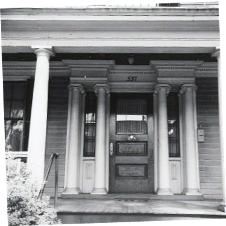 | 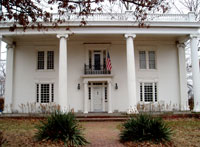 | 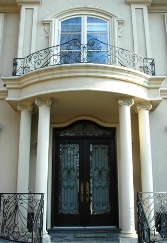 |
| It looks like an late 1800's house. Twin Ionic capitals at twin sidelights and the porch is Tuscan columns. The entablature at the doorway are very heavy with a large cornice molding. | An Antebellum period home. Very tall and slender Ionic columns. | Four Ionic columns flanking an entry portico. Nice curved entablature with heavy cornice making a balcony. Good wirework. |
click to enlarge 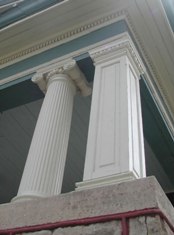 | click to enlarge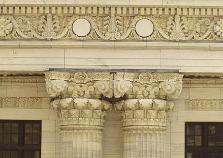 | click to enlarge 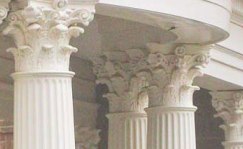 |
| A beautiful set of columns. The left is a very traditional, full scroll ionic, fluted column with the egg & dart echinus. The twin square paneled column is tied with the egg & dart at the echinus also. Notice the small beaded chaplet at the bottom of the echinus. A nicely colored entablature corniced with dental mold. | A nice old stone corinthian with a banded entablature. The highly decorative freize is bubeautiful capped with dental. | A nice set of corinthian columns under a curved entablature. |
click to enlarge 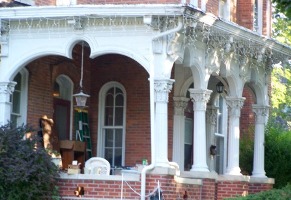 | click to enlarge 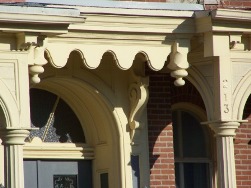 | |
| Beautiful corinthians on a home porch. Nice heavy, arched entablature. The 3/4 circle in the arch is very nice. At the back of the porch there's a nice example of an engaged square corinthian pilaster. Notice the arched panes in the arched window. | This is an entry. Slender, fluted Dorian columns with arched entablature. The four-lobbed spandrel with dropped pendants. Swans-neck corbels on a deep, paneled transom. |
Triglyphs, metopes, and the frieze ???
Triglyph
From Wikipedia, the free encyclopedia
Jump to: navigation, search
Triglyph is an architectural term for the vertically channeled tablets of the Doric frieze, so called because of the angular channels in them, two perfect and one divided, the two chamfered angles or hemiglyphs being reckoned as one. The rectangular recessed spaces between the triglyphs on a Doric frieze are called metopes. The raised spaces between the channels themselves (within a triglyph) are called femur in Latin or meros in Greek.[1]The triglyph is largely thought to be a tectonic representation in stone of the wooden beam ends of the typical primitive hut, as described by Vitruvius and Renaissance writers. The wooden beams were notched in three separate places in order to cast their rough-cut ends mostly in shadow. Greek architecture (and later Roman architecture) preserved this feature, as well as many other features common in original wooden buildings, as a tribute to the origins of architecture and its role in the history and development of man.
In terms of structure, a triglyph may be carved from a single block with a metope, or the triglyph block may have slots cut into it to allow a separately cut metope (in stone or wood) to be slid into place, as at the Temple of Aphaea. There may be some variation in design within a single structure to allow for corner contraction, an adjustment of the column spacing and arrangement of the Doric frieze in a temple to make the design appear more harmonious.
Monday, October 15, 2012
Masonry comes alive
I had the pleasure of attending a Fellowcraft Degree at Linden lodge this evening. Myself along with around 60 brothers witnessed one of the most touching things I have ever seen in any lodge at anytime.
Linden has a brother who has been deaf since birth. This brother who is a little mature asked his father in-law what the brothers were saying when the flag was presented at the altar. His father in-law who happens to be a Past Master of Linden lodge explained that the brothers were reciting the pledge of allegiance to the flag of the United States of America.
Apparently when this brother was in school they were never taught the pledge and this was many years ago. Probably because he received his education along with other deaf students and they were not able to recite it.
This brother took it upon himself to learn the pledge and how to sign it. Now when the flag is presented he approaches the altar and as the rest of us recited the pledge he signs the pledge. This is something he is very proud of.
This evening was the first time I had witnessed this great event. I have never been more proud of any brother or this great fraternity, it truly brought tears to my eyes and warmed my heart. To think that this man, this brother had journeyed through life and it was this great fraternity that enriched his life and knowledge of this tradition that many of us take for granted.
It was very fitting and ironic that this was taking place before the Fellowcraft or the "education" degree was conferred. As we all know a part of the Fellowcraft degree deals with the five human senses which includes hearing.
Now to top off the evening this brother was brought to the East along with a couple of other brothers and was presented with a riutal pin which was presented by the District Deputy Instructor. He received the pin for learning the pledge and how to sign it.
You've heard me say numerous times a great night in Masonry......this was an AWESOME night in Masonry......and I am very glad I was there to witness it firsthand.
Linden has a brother who has been deaf since birth. This brother who is a little mature asked his father in-law what the brothers were saying when the flag was presented at the altar. His father in-law who happens to be a Past Master of Linden lodge explained that the brothers were reciting the pledge of allegiance to the flag of the United States of America.
Apparently when this brother was in school they were never taught the pledge and this was many years ago. Probably because he received his education along with other deaf students and they were not able to recite it.
This brother took it upon himself to learn the pledge and how to sign it. Now when the flag is presented he approaches the altar and as the rest of us recited the pledge he signs the pledge. This is something he is very proud of.
This evening was the first time I had witnessed this great event. I have never been more proud of any brother or this great fraternity, it truly brought tears to my eyes and warmed my heart. To think that this man, this brother had journeyed through life and it was this great fraternity that enriched his life and knowledge of this tradition that many of us take for granted.
It was very fitting and ironic that this was taking place before the Fellowcraft or the "education" degree was conferred. As we all know a part of the Fellowcraft degree deals with the five human senses which includes hearing.
Now to top off the evening this brother was brought to the East along with a couple of other brothers and was presented with a riutal pin which was presented by the District Deputy Instructor. He received the pin for learning the pledge and how to sign it.
You've heard me say numerous times a great night in Masonry......this was an AWESOME night in Masonry......and I am very glad I was there to witness it firsthand.
Wednesday, October 10, 2012
Never know what is on the web
Symbolism of Charcoal
By Wor. H. Meij


We learn in the first degree lecture, that EA’s serve their Masters with “Freedom,
Fervency and Zeal”, symbolized by chalk, charcoal and
clay. Why charcoal?
In many cultures, charcoal was seen as a wondrous substance, for it
made possible the use of metals. Its fervency, or great heat, was critical to
refining progressively harder and harder metals, from lead to copper, brass to bronze, and
iron to steel. In the lecture we learn that “Nothing is more fervent than Charcoal, to
which, when well ignited, the most obdurate metals will yield.” It is interesting and
instructive that the term “obdurate” carries the meanings “hardened in wickedness”,
“persistently impenitent”, and “resisting or insensible to moral influence”. Thus
a second service is expected of our Brother, namely to ignite himself in his search for a
better moral foundation and strive to fit himself for the Builder’s use.
The Romans
marked festive days on their calendats with lime (or white chalk) and unlucky days with
charcoal, perhaps herein lie one association often made in many cultures that
black=unlucky, white = lucky.
A Korean tradition is to wait twenty-one days
before visiting a new mother and child. All visitations are restricted during this time
period, and ropes are hung across the gate to keep people out. These ropes, called kumchul
(or geumjul), are decorated according to the sex of the child. Charcoal, white paper, and
pine needles let people know that a girl has been born; charcoal and red paper (sometimes
peppers) signify that a boy has been born to the family. The charcoal symbolizes
cleanliness, red symbolizes the male, pine needles symbolize chastity in women, and white
is to prevent impurities from entering the house. 
Charcoal is also a symbol of absorption, coming from the same physical
properties it possesses, and hence was often used as a symbol of quick absorption of
thoughts and lessons. It is the porosity of wood charcoal that explains why it floats on
the surface of water, although it is actually denser. This also accounts for its ability
to readily absorb gases and liquids; charcoal is often used to filter water or absorb
odors. Its pharmacological action depends on the same property; it absorbs the gases of
the stomach
and intestines,
and also liquids and solids (hence its use in the treatment of certain poisonings).
Charcoal filters are used in some types of gas
mask to remove poisonous gases from inhaled air.
To dream of charcoal unlighted, denotes miserable situations and bleak
unhappiness. If it is burning with glowing coals, there is prospects of great enhancement
of fortune, and possession of unalloyed joys.
Might just be my favorite
We had the pleasure of conferring the Entered Apprentice degree last evening at Mt.Morris Lodge #535.
Given the fact that there were other activities going on in the county we had a very nice showing of brothers from various lodges. Without the help of all the traveling brothers it would be extremely difficult to confer any degree.
Our candidate was a slightly mature gentleman, who made everyone a little nervous because of his arriving about 15 minutes before opening lodge. In talking with him he indicated that he had been helping a friend of his who happens to be partially disabled. She is a single woman who cleans an office building and he goes along to help with the heavy lifting and more physically challenging work. He does this voluntarily to help her earn extra money.
The above little scenario set the tone of the evening for me. I knew in my heart and mind that he was already a Mason without the degrees.
My job prohibits me from arriving on time for dinner.....but it gives me the opportunity to walk into the dining hall and see and experience the fellowship that is taking place. Plenty of conversation, laughter, and hand-shakes are taking place and you can sense the energy of brotherhood. Try it sometime....show up about 15 minutes late and witness it for yourself....it's truly the spirit of our fraternity at work.
The Entered Apprentice Degree might very well be my favorite degree. It is so rich with symbolism and heritage. If you have an attentive candidate you can see him taking it all in. The apron presentation is without a doubt the most beautiful part of any of the three degrees....that's just my opinion of course.
As you can probably tell it was an excellent night in Masonry.....the lectures were flawlessly given and the whole degree went very smooth....with perhaps the exception of the Master(me) who had a couple of senior moments and inter-mingling of degrees.....the key is the JEA method of ritual delivery just keep going, go back and include if possible....if not press on and make it fit.....in the Scottish Rite we do some ad-libbing because we just don't get the practice like blue lodge....but hey we are all human and provided the proper intent is there and we are getting about 90% right we are doing a good job.
In conclusion brothers....get out and travel.....experience the spirit of the fraternity !!!!
Given the fact that there were other activities going on in the county we had a very nice showing of brothers from various lodges. Without the help of all the traveling brothers it would be extremely difficult to confer any degree.
Our candidate was a slightly mature gentleman, who made everyone a little nervous because of his arriving about 15 minutes before opening lodge. In talking with him he indicated that he had been helping a friend of his who happens to be partially disabled. She is a single woman who cleans an office building and he goes along to help with the heavy lifting and more physically challenging work. He does this voluntarily to help her earn extra money.
The above little scenario set the tone of the evening for me. I knew in my heart and mind that he was already a Mason without the degrees.
My job prohibits me from arriving on time for dinner.....but it gives me the opportunity to walk into the dining hall and see and experience the fellowship that is taking place. Plenty of conversation, laughter, and hand-shakes are taking place and you can sense the energy of brotherhood. Try it sometime....show up about 15 minutes late and witness it for yourself....it's truly the spirit of our fraternity at work.
The Entered Apprentice Degree might very well be my favorite degree. It is so rich with symbolism and heritage. If you have an attentive candidate you can see him taking it all in. The apron presentation is without a doubt the most beautiful part of any of the three degrees....that's just my opinion of course.
As you can probably tell it was an excellent night in Masonry.....the lectures were flawlessly given and the whole degree went very smooth....with perhaps the exception of the Master(me) who had a couple of senior moments and inter-mingling of degrees.....the key is the JEA method of ritual delivery just keep going, go back and include if possible....if not press on and make it fit.....in the Scottish Rite we do some ad-libbing because we just don't get the practice like blue lodge....but hey we are all human and provided the proper intent is there and we are getting about 90% right we are doing a good job.
In conclusion brothers....get out and travel.....experience the spirit of the fraternity !!!!
Monday, October 8, 2012
Behold How Good and How Pleasant
Had some great fellowship over the weekend. For starters, Friday night attended Grand Blanc's fish-fry. They had a nice crowd and we had a full table of brothers and their ladies. It is really neat to get together and break bread and have some nice conversation.
Saturday, we had our monthly Country Breakfast at Mt.Morris. Another great opportunity for fellowship. Unfortunately we were very short-handed...but there were a few Masons and Stars who really stepped up and made it a success.
The most interesting conversation concerning the craft was had between myself and one of our junior officers. We went to another activity which was eventually cancelled because of circumstances beyond our control....however, we made the most of our time and had a great conversation about getting the newer members interested enough to come back.
In talking with this brother who is in the "younger" age group, he mentioned that he had his own ideas about why the newly made Masons are not coming back to take part in the activities of the lodge. He summed up his feelings to three simple words----it's too easy-----
He feels that they have very little invested financially, and they have very little time invested. They pay a little over a hundred bucks to get in.....they invest three evenings....and bam---they are a Master Mason. Their dues are good for the balance of the year, they have probably less than an hour invested in learning their "lessons"....they find out all of the "supposed secrets" and there is nothing left for them to learn or to work at.
I know what most of you are thinking.....there are dozens, hundreds, if not thousands of things to learn. In their mind they have learned everything they need because after-all they are Master Masons. This young officer alluded to the "old days" when an initiate was made an EA they had to invest some real time and real effort to pass the "test" before moving on to the next degree. In learning that lesson they worked their butt off and also built a relationship with one or more brothers preparing to be tested.
He also noted that we as a fraternity have lost sight of membership, in his opinion it is a "honor and privilege" to be a Master Mason.....we, the fraternity, because of our starving for membership, consider it a privilege to have them join and in his opinion that is opposite of how it should be. He also noted that he has never seen anyone turned down for any reason.....it's almost like the old mirror test.....if you can fog this mirror---you're in.
There is much to be learned from this conversation. The words that the RWDGM Ray Lemons spoke of at the summit meeting----they are joining us....we are not joining them. Are we so starved for members that we move them through too rapidly? Only to have them be raised to the sublime degree of a MM so they have no reason to come back......I'm not sure.
The one thing I do know is that with some exclusivity, protecting our ritual, letting a certain air of mystique be known, filtering the candidates through a more thorough investigation, and maybe prolonging advancement, and getting them involved in lodge activities inside and outside the confines of the temple just might be our ticket to ensuring the everlasting longevity of this fine fraternity.
Saturday, we had our monthly Country Breakfast at Mt.Morris. Another great opportunity for fellowship. Unfortunately we were very short-handed...but there were a few Masons and Stars who really stepped up and made it a success.
The most interesting conversation concerning the craft was had between myself and one of our junior officers. We went to another activity which was eventually cancelled because of circumstances beyond our control....however, we made the most of our time and had a great conversation about getting the newer members interested enough to come back.
In talking with this brother who is in the "younger" age group, he mentioned that he had his own ideas about why the newly made Masons are not coming back to take part in the activities of the lodge. He summed up his feelings to three simple words----it's too easy-----
He feels that they have very little invested financially, and they have very little time invested. They pay a little over a hundred bucks to get in.....they invest three evenings....and bam---they are a Master Mason. Their dues are good for the balance of the year, they have probably less than an hour invested in learning their "lessons"....they find out all of the "supposed secrets" and there is nothing left for them to learn or to work at.
I know what most of you are thinking.....there are dozens, hundreds, if not thousands of things to learn. In their mind they have learned everything they need because after-all they are Master Masons. This young officer alluded to the "old days" when an initiate was made an EA they had to invest some real time and real effort to pass the "test" before moving on to the next degree. In learning that lesson they worked their butt off and also built a relationship with one or more brothers preparing to be tested.
He also noted that we as a fraternity have lost sight of membership, in his opinion it is a "honor and privilege" to be a Master Mason.....we, the fraternity, because of our starving for membership, consider it a privilege to have them join and in his opinion that is opposite of how it should be. He also noted that he has never seen anyone turned down for any reason.....it's almost like the old mirror test.....if you can fog this mirror---you're in.
There is much to be learned from this conversation. The words that the RWDGM Ray Lemons spoke of at the summit meeting----they are joining us....we are not joining them. Are we so starved for members that we move them through too rapidly? Only to have them be raised to the sublime degree of a MM so they have no reason to come back......I'm not sure.
The one thing I do know is that with some exclusivity, protecting our ritual, letting a certain air of mystique be known, filtering the candidates through a more thorough investigation, and maybe prolonging advancement, and getting them involved in lodge activities inside and outside the confines of the temple just might be our ticket to ensuring the everlasting longevity of this fine fraternity.
Thursday, October 4, 2012
CBC
It seems that our world is filled with acronyms or the use of a few initials to represent a certain phrase or title.
CBC is one we need to get familiar with as it will be one of the hot topics in our world of Freemasonry here in the Grand Jurisdiction of Michigan.
CBC or Criminal Background Check is an issue which the Grand Lodge of Michigan feels very strongly about. CBCs are a current component of life for many of us. Whether applying for a job, a professional organization, volunteering to help with youth groups, and many other situations.
It is a reflection of the society in which we live. Society is much more mobile than in prior decades. It is not unlikely for younger people to hold in excess of 7-10 jobs in their lifetime and very unlikely that they remain in the same locale.
Given the huge influx of internet leads generated by the Grand Lodge website we are receiving many inquiries for membership and the majority of the time we really don't know the applicant.
In reading some BGP reports, I have noted that some lodges require that the applicant attend various social functions of the lodge so they can get to know the applicant, a great idea. We are so starved for membership that we have not been doing a good job of investigating who wants to join us. RWDGM Lemons stated that we have to remember the applicant is joining us...we are not joining them.
The Grand Master has also stated that there are some issues that have occurred that may have never happened had we had a CBC program in place.
The issue of privacy and confidentiality has come up and the company which is chosen to do the CBC will also be the custodian of the records, and that the local lodges and GL will not have access to these reports for retention.
As mentioned before just exactly what is our fraternity worth? Is it worth screening potential new members to safeguard our members, members families, and our reputation. The question has been posed, what if a policeman, attorney, judge, cpa, clergyman, or others who may have been through the CBC....or for that matter a grandson, son, nephew, or other relative of an existing member applies for membership do they go thru the same CBC process......the answer is yes.....and here is why......if want to open ourselves up to potential lawsuits then this would surely lead to that....by excluding certain groups and not including all who apply is morally and ethically wrong but probably against some law...not sure I'm not an attorney. I feel the professionals would see it as good thing by protecting our reputation......and I'm sure that any parent will agree that we know everything our sons, grandsons, and nephews have been involved in...right....probably not.....so everyone goes thru the same process.....then we know and are being fair and equitable.
In conclusion is our fraternity worth requiring a potential member to jump thru this hoop....in my opinion most certainly.....YES
CBC is one we need to get familiar with as it will be one of the hot topics in our world of Freemasonry here in the Grand Jurisdiction of Michigan.
CBC or Criminal Background Check is an issue which the Grand Lodge of Michigan feels very strongly about. CBCs are a current component of life for many of us. Whether applying for a job, a professional organization, volunteering to help with youth groups, and many other situations.
It is a reflection of the society in which we live. Society is much more mobile than in prior decades. It is not unlikely for younger people to hold in excess of 7-10 jobs in their lifetime and very unlikely that they remain in the same locale.
Given the huge influx of internet leads generated by the Grand Lodge website we are receiving many inquiries for membership and the majority of the time we really don't know the applicant.
In reading some BGP reports, I have noted that some lodges require that the applicant attend various social functions of the lodge so they can get to know the applicant, a great idea. We are so starved for membership that we have not been doing a good job of investigating who wants to join us. RWDGM Lemons stated that we have to remember the applicant is joining us...we are not joining them.
The Grand Master has also stated that there are some issues that have occurred that may have never happened had we had a CBC program in place.
The issue of privacy and confidentiality has come up and the company which is chosen to do the CBC will also be the custodian of the records, and that the local lodges and GL will not have access to these reports for retention.
As mentioned before just exactly what is our fraternity worth? Is it worth screening potential new members to safeguard our members, members families, and our reputation. The question has been posed, what if a policeman, attorney, judge, cpa, clergyman, or others who may have been through the CBC....or for that matter a grandson, son, nephew, or other relative of an existing member applies for membership do they go thru the same CBC process......the answer is yes.....and here is why......if want to open ourselves up to potential lawsuits then this would surely lead to that....by excluding certain groups and not including all who apply is morally and ethically wrong but probably against some law...not sure I'm not an attorney. I feel the professionals would see it as good thing by protecting our reputation......and I'm sure that any parent will agree that we know everything our sons, grandsons, and nephews have been involved in...right....probably not.....so everyone goes thru the same process.....then we know and are being fair and equitable.
In conclusion is our fraternity worth requiring a potential member to jump thru this hoop....in my opinion most certainly.....YES
Wednesday, October 3, 2012
vouchsafe and others
vouchsafe
verb (used with object)
1. to grant or give, as by favor, graciousness, or condescension: to vouchsafe a reply to a question.
2. to allow or permit, as by favor or graciousness: They vouchsafed his return to his own country.
We have all heard this word numerous times......Vouchsafe Thine aid almighty Father of the Universe
to this our present convention.
Convention is used to indicate a meeting or formal assembly....hmmmm.....quite interesting.
Endue him with a competency of Thy Divine wisdom.......if you explore the meaning of the word endue....
to invest or endow with some gift, quality, or faculty.
Therefore we are asking the Grand Architect of the Universe to aid us by granting through his graciousness and to allow the candidate at this assembly or meeting to be endowed or invested with the skills, knowledge and qualifications of the wisdom of God.
Four words that pack a powerful request into a few small sentences that we often take for granted.
Brothers.....our ritual is more than worth the price of admission to our fraternity if we open our minds to the
true meaning the words represent.
Subscribe to:
Posts (Atom)


